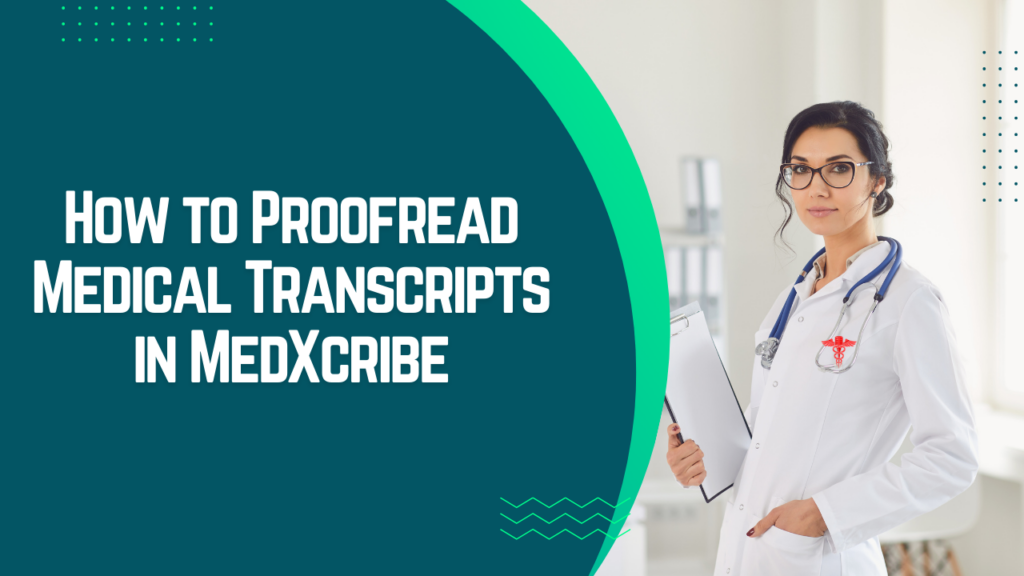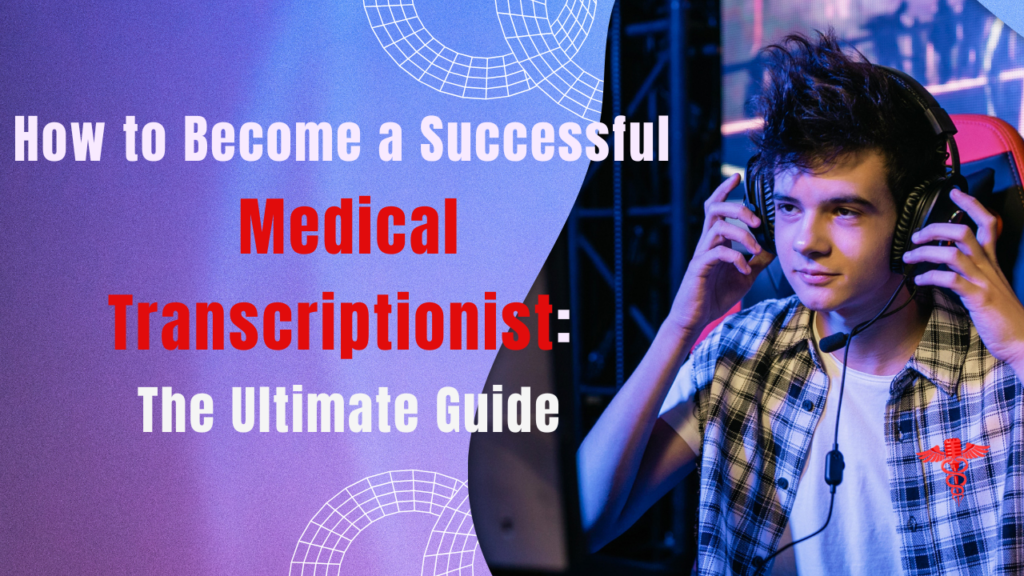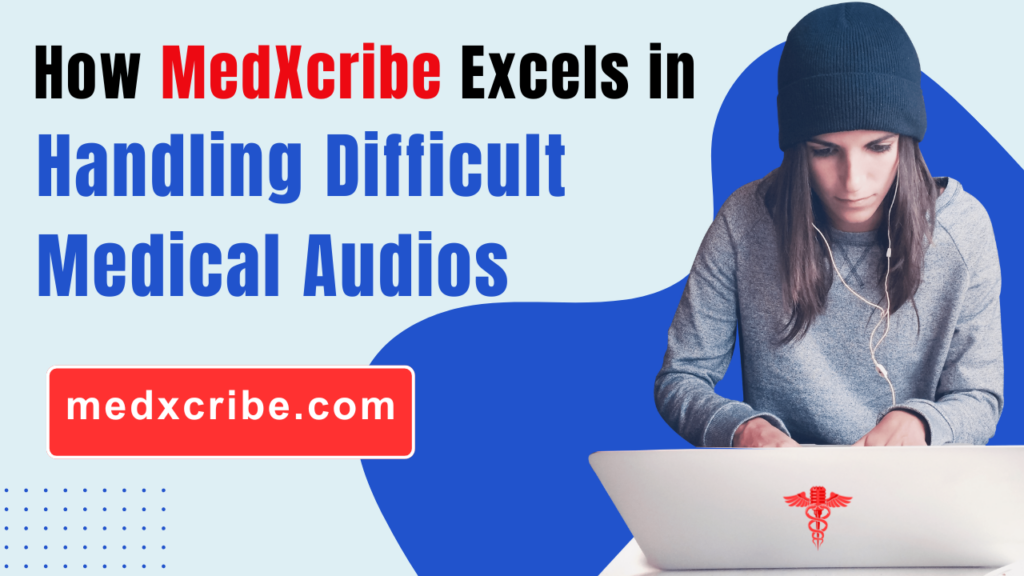Cardiology Transcription Quiz: Listen to the Audio & Pick the Right Transcript!

Dental Transcription Quiz: Listen to the Audio & Pick the Right Transcript!

Diabetes Transcription Quiz: Listen to the Audio & Pick the Right Transcript!

How to Proofread Medical Transcripts in MedXcribe

Medical transcription requires accuracy and efficiency, and MedXcribe makes the process seamless with Real-Time Editing and Audio-Transcript Syncing. Whether you’re a medical professional, transcriptionist, or student, MedXcribe helps you proofread and edit transcripts effortlessly. https://youtu.be/-bGcF0b0rIM Step 1: Upload and Transcribe To begin, open the MedXcribe app, upload your audio file or YouTube URL, and click Transcribe. In just a few minutes, MedXcribe generates an accurate transcript, eliminating the need for manual transcription and saving you valuable time. Step 2: Proofread with Audio-Transcript Syncing MedXcribe’s Audio-Transcript Syncing ensures smooth and precise proofreading. As the audio plays, the transcript automatically scrolls and highlights the corresponding text, making it easy to follow along. If you need to review a specific section, simply tap on any word, and the audio will jump to that moment, helping you verify and correct any part of the transcript effortlessly. Step 3: Edit in Real Time With Real-Time Editing, you can instantly modify the transcript as needed. Tap on a word or phrase to correct errors, and MedXcribe will apply the changes seamlessly across the entire document. Every occurrence of the corrected word updates automatically, saving time and ensuring accuracy without the need for repetitive edits. Step 4: Save and Download Once you have reviewed and finalized the transcript, simply save or download it in your preferred format. MedXcribe ensures that your transcripts are polished and ready for use with minimal effort. Why Use MedXcribe? MedXcribe simplifies medical transcription by providing fast and accurate transcriptions, effortless proofreading, and seamless real-time editing. Instead of manually searching for errors or struggling with time-consuming corrections, MedXcribe automates the process, allowing you to focus on accuracy and efficiency. With Real-Time Editing and Audio-Transcript Syncing, proofreading medical transcripts has never been easier. Try MedXcribe today and experience a faster, more accurate way to handle medical transcription.
Doctor-Patient Conversation Quiz: Listen & Pick the Right Transcript!

How to Earn from Home with Medical Transcription

Medical transcription is a great way to earn money from home, especially if you have strong listening and typing skills. A solid knowledge of medical terminology, keen attention to detail, and a passion for medicine can make this career a perfect fit. But is it still a profitable path today? Let’s explore the facts and discover the best ways to get started in medical transcription! Why Choose Medical Transcription? Medical transcription involves listening to recorded medical reports and converting them into written documents. Doctors, hospitals, and clinics need accurate records of patient care, and transcriptionists play a crucial role in this process. Unlike general transcription, medical transcription requires knowledge of medical terminology, so it pays better and has more stable job opportunities. Best Platforms for Medical Transcription Jobs Here is a breakdown of the top platforms where you can find medical transcription jobs (as of 2024): Platform Availability Earnings Rev.com Hiring in select countries $0.54 – $1.20 per audio minute GoTranscript International, strict test Up to $0.60 per audio minute Escribers.net US only (Legal & Medical) Competitive rates 3Play Media Hiring (English & Spanish) AI editors & transcribers Daily Transcription Hiring (Medical, Legal, General) AI editors & transcriptionists SpeechPad Not hiring Not specified WayWithWords Not hiring Not specified GMR Transcription Not hiring Not specified How to Start in Medical Transcription? If you’re new to this field, here’s how you can get started: Step 1: Learn Medical Terminology Take an online course in medical transcription. Learn common medical abbreviations and terms. Familiarize yourself with AI-powered transcription tools like MedXcribe, which enhance accuracy and efficiency. Step 2: Build Your Skills Practice fast and accurate typing. Improve listening and grammar skills. Learn how to use AI-assisted transcription software to streamline your workflow. Get familiar with speech-to-text AI tools to speed up transcription. Step 3: Apply for Jobs Start with freelance platforms like Fiverr, Upwork, and People Per Hour. Apply to specialized medical transcription platforms like Rev, 3Play Media, Escribers, or MedXcribe. Network on LinkedIn and Indeed for AI-enhanced transcription job opportunities. Look for companies hiring AI editors who refine AI-generated transcripts. Step 4: Get Certified (Optional but Recommended) Consider earning a Certified Medical Transcriptionist (CMT) certification. Gain experience with AI-driven medical documentation software. Certification and AI skills will help you secure higher-paying jobs and stay competitive in the evolving industry. By integrating AI-powered tools like MedXcribe, you can increase productivity, improve accuracy, and enhance your job prospects in the growing medical transcription field!For a detailed guide on becoming a successful medical transcriptionist, click here: How to Become a Successful Medical Transcriptionist Why Medical Transcription is a Smart Career Choice Work from anywhere – A flexible, remote job option. Steady demand – Hospitals and clinics need accurate records. Higher pay than general transcription – Specialized knowledge means better income. Opportunities for growth – Gain experience and move into medical coding or editing. If you want a flexible and rewarding career, medical transcription is a great choice! With the right skills and training, you can start earning from home quickly. Ready to begin? Build your skills, apply to top platforms, and start your medical transcription journey today!
How to Transcribe YouTube Videos Instantly with MedXcribe

Have you ever wished you could turn YouTube videos, especially medical ones, into text instantly? Now you can! MedXcribe is an AI-powered tool that transcribes any YouTube video in just one click. No hassle, no delays—just fast, accurate, and effortless transcription. Whether you’re a content creator, student, researcher, or professional, having a text version of a video saves time, improves accessibility, and makes it easier to find key information. https://youtu.be/AJeXchKYOk4 Step-by-Step Guide to Transcribing YouTube Videos Step 1: Copy the YouTube URL To begin, open YouTube and find the video you want to transcribe. Copy the video URL from the address bar. Step 2: Go to MedXcribe Visit the MedXcribe website and navigate to the transcription tool. Paste the YouTube link into the designated field and click Load. MedXcribe will process the video and download the audio in just a few minutes. Step 3: Automatic Transcription Once the audio is processed, MedXcribe will transcribe it within seconds using its advanced AI-powered speech recognition. The result is an accurate, well-structured transcript ready for review. Step 4: Review and Edit (If Needed) Your transcript will be displayed on the screen. If necessary, you can edit and refine it for accuracy, formatting, or readability. Step 5: Save or Download the Transcript Once you’re happy with the transcript, save or download it in your preferred format—TXT, JSON, or SRT for subtitles. Why Use MedXcribe for YouTube Transcription? One-Click Transcription – No manual typing, just upload and transcribe.Fast and Accurate – AI-powered technology ensures high precision.Supports Multiple Languages – Great for international content creators.24/7 Availability – Transcribe videos anytime, anywhere.Secure & Confidential – Keeps your data protected.Saves Time & Effort – Perfect for students, professionals, and researchers. Who Can Benefit from MedXcribe? Content Creators & YouTubers – Convert videos into blogs, scripts, or captions.Students & Educators – Get study notes from lectures and online courses.Researchers & Journalists – Extract key points from interviews and discussions.Business Professionals – Generate transcripts for meetings, webinars, and training videos. Start Transcribing YouTube Videos Today! Why spend hours manually transcribing when MedXcribe can do it in seconds? Whether you’re a content creator, student, business professional, or researcher, this tool makes transcribing YouTube videos fast, easy, and highly accurate. Try it now and experience effortless transcription! Got questions? Drop them in the comments below!
How to Handle Word Corrections in Medical Transcriptions with MedXcribe

https://www.youtube.com/watch?v=i4GcOYtIxG8 Accurate medical transcriptions are essential in healthcare, but mistakes can happen. Thankfully, MedXcribe makes correcting those mistakes quick and simple. In this blog, we’ll walk you through how to easily fix errors in medical transcriptions using MedXcribe. Let’s dive in! What is MedXcribe? MedXcribe is a fast and efficient tool designed to help healthcare professionals transcribe medical audio into accurate text. It’s specifically built for medical transcriptions, making it easy to convert voice recordings into written notes while maintaining precision. MedXcribe also offers an intuitive word correction feature, ensuring your transcriptions are error-free in just a few simple steps. Step 1: Start Transcribing with MedXcribe To begin, open the MedXcribe app, upload your audio, and click ‘Transcribe.’ MedXcribe will start processing your audio and quickly convert it into text. Step 2: Watch It Transcribe in Minutes MedXcribe works fast, even with long audio files. It will transcribe your audio accurately in just a few minutes, saving you time and effort. Step 3: Review the Transcription Once the transcription is ready, take a moment to review it. Look over the text carefully to spot any mistakes, such as incorrect names or medical terms. Step 4: Correct Mistakes with Word Correction If you find any errors, don’t worry! Simply go to the ‘Word Correction’ option, type in the correct word, and click ‘Transcribe.’ MedXcribe will automatically apply the correction throughout the entire transcription. Step 5: Automatic Updates for Accuracy MedXcribe will automatically update every occurrence of the corrected word throughout the text. This ensures the transcription is accurate without you needing to make manual updates. Step 6: Final Check and Save Once you’re happy with the transcription and all corrections are made, give it one last review. If everything looks good, you can save or download the transcription in your preferred format. And that’s it! Correcting word errors with MedXcribe is fast and easy. In just a few simple steps, MedXcribe ensures that your medical transcriptions are both accurate and efficient. Give it a try today and share your feedback!
How to Become a Successful Medical Transcriptionist: The Ultimate Guide

Medical transcriptionists play a vital role in healthcare, ensuring accurate and efficient documentation that supports patient care. With advancements in technology, especially the integration of AI , the field is evolving rapidly. If you’re looking to start or advance your career in medical transcription, this guide will provide insights into essential skills, training opportunities, and job prospects. https://youtu.be/eFNPptXJwrc 1. Education Qualifications to Become a Medical Transcriptionist High School Diploma or Equivalent A high school diploma is the minimum educational requirement. Strong skills in Languages, grammar, and typing are essential. Post-Secondary Training (Optional but Recommended) Enroll in a Medical Transcription Training Program from community colleges, online platforms, or vocational schools. These programs cover: Medical terminology Anatomy and physiology Grammar and editing skills Transcription software usage Certification (Optional but Beneficial) Certification can boost your career prospects and credibility. Common certifications include: RHDS (Registered Healthcare Documentation Specialist): For entry-level transcriptionists. CHDS (Certified Healthcare Documentation Specialist): For experienced professionals. Offered by the Association for Healthcare Documentation Integrity (AHDI). Knowledge of Medical Terminology and Technology Develop familiarity with medical terms, transcription tools, and compliance standards like HIPAA. Some programs integrate these into their training. On-the-Job Training Many transcriptionists gain additional skills and refine their expertise through hands-on experience in clinics, hospitals, or transcription companies. While formal education isn’t always mandatory, completing a specialized program and earning certifications can significantly improve your employability and earning potential in this field. 2. Essential Skills for Medical Transcriptionists To thrive in medical transcription, you need a unique combination of technical expertise, attention to detail, and adaptability. Here are the critical skills required: Typing Proficiency and Accuracy (Must Have) Typing Speed: Aim for 60-75 words per minute or more. Accuracy: Minimize errors, as even small mistakes can have serious consequences in patient care. Knowledge of Medical Terminology (Must Have) Understand medical terms, abbreviations, anatomy, and pharmacology. Use medical dictionaries and references to verify terms when necessary. Excellent Listening Skills (Must Have) Accurately interpret audio recordings, even with background noise or heavy accents. Understand nuanced medical terms and instructions. Attention to Detail (Must Have) Ensure all documentation is accurate, from patient records to billing codes. Double-check all work to eliminate errors. Confidentiality and Ethics (Must Have) Follow HIPAA guidelines and maintain strict patient confidentiality. Handle sensitive medical information responsibly. Strong Grammar and Writing Skills (Highly Recommended) Write clear and concise reports that are grammatically correct. Prioritize clarity by avoiding long and complex sentences. Adaptability and Trainability (Highly Recommended) Quickly learn new software and office protocols. Stay updated with changes in the healthcare and transcription industries. Technological Proficiency (Recommended) Use transcription software, voice recognition tools, and foot pedals. Stay comfortable with platforms like ScribeMD.ai and other AI-powered transcription tools. Multitasking Ability (Optional but Beneficial) Listen to dictations while typing and inputting data simultaneously. Juggle multiple tasks efficiently without sacrificing quality. Commitment to Lifelong Learning (Optional but Beneficial) Stay updated with medical advancements and new technologies. Pursue certifications like RHDS (Registered Healthcare Documentation Specialist) or CHDS (Certified Healthcare Documentation Specialist). 3. Where to Learn Medical Transcription Online There are many platforms offering training programs in medical transcription. Here’s a comparison: Platform Description Key Benefit Approx. Cost Duration Level Website Alison Free courses on medical transcription with optional paid certifications. Cost-effective for learners on a budget. Free, ~$30 for certificates 1-3 hours Beginner Alison Udemy Affordable courses on medical transcription with lifetime access. Cost-effective with a wide range of courses. ~$15-$50 (on sale) 2-10 hours Beginner-Intermediate Udemy LinkedIn Learning Courses on medical transcription basics and medical terminology. Certifications displayable on LinkedIn profiles. ~$29.99/month 1-5 hours Beginner LinkedIn Learning Ashworth College Comprehensive career diploma program covering terminology and transcription. Affordable tuition with payment plans. ~$800-$1,200 4-12 months Beginner Ashworth College 360training Specialized in transcription training, including HIPAA compliance. Includes job placement assistance. ~$1,500-$2,000 Self-paced Beginner-Intermediate 360training Coursera Courses in medical transcription and healthcare documentation from reputed institutions. Flexible scheduling and high-quality content. Free to audit, ~$49/month 4-12 weeks Beginner-Intermediate Coursera CareerStep Hands-on transcription and editing training program. Industry-recognized certification and job placement support. ~$2,999 4-6 months Beginner-Advanced CareerStep AHDI Official association offering certifications and resources for transcriptionists. Industry-standard certifications like RHDS and CHDS. ~$125-$300 for exams Self-paced Advanced AHDI Notes: Alison: Best for beginners; free or low-cost courses to explore transcription basics. LinkedIn Learning: Beginner-friendly with short, affordable courses and LinkedIn certifications. Udemy: Budget-friendly and beginner-focused, offering a range of quick and practical courses. Ashworth College: Comprehensive and affordable diploma program tailored for beginners. 360training: Offers intermediate-level training with HIPAA compliance and job placement assistance. Coursera: Flexible and high-quality courses from reputed institutions, suitable for beginners to intermediate learners. CareerStep: Advanced training with hands-on experience, industry certifications, and job placement support. AHDI: Advanced-level certifications (RHDS, CHDS) with global recognition and a focus on setting industry standards. 4. Job Opportunities for Medical Transcriptionists There are diverse career opportunities for medical transcriptionists across industries. Below is an overview: Category Potential Employers/Platforms Job Roles/Opportunities Scope Estimated Salary Packages Remote/Work-from-Home Jobs Freelancing Websites: Upwork, Freelancer, Fiverr Remote Job Boards: FlexJobs, Remote.co Freelance transcription services and remote job opportunities. Ideal for flexible schedules; opportunities to build a diverse client base. $15–$30/hour Freelance/Independent Work Independent physicians, small clinics, private healthcare professionals Start your own transcription business or work as a freelancer. Unlimited earning potential based on skill, specialization, and client base. $20–$50/hour (variable income) Transcription Service Providers ScribeAmerica, Nuance, M*Modal, iMedX Remote or part-time transcription jobs. Steady demand for outsourcing transcription to handle large workloads for multiple clients. $20–$25/hour Educational Institutions Medical schools, training institutions Transcribe lectures, training materials, and research notes. Niche opportunities to assist academic institutions with high documentation needs. $35,000–$50,000/year Healthcare Facilities Hospitals, Clinics, Private Practices, Specialty Practices Transcribe physician notes, diagnostic reports, and operative procedures. High demand for accurate documentation in patient care and compliance. $30,000–$45,000/year (entry-level), up to $60,000/year (experienced) Legal and Insurance Companies Legal firms, insurance companies Transcribe medico-legal documents and assist with medical claims. Growing demand for transcriptionists familiar with both medical and legal terminology. $35,000–$60,000/year Government and Public Health Organizations Government
How MedXcribe Excels in Handling Difficult Medical Audios

Medical transcriptionists play a crucial role in healthcare, converting spoken medical records into precise written documentation. However, poor audio quality introduces significant challenges, affecting efficiency, accuracy, and productivity. Below, we outline the obstacles caused by poor audio quality and how MedXcribe excels in addressing them. What is MedXcribe? MedXcribe is an innovative medical transcription app that transforms voice recordings into accurate and secure medical records—all offline. Designed to overcome challenges like poor audio quality, MedXcribe leverages advanced AI technology to enhance clarity, transcribe complex medical terminology, differentiate speakers, and adapt to diverse accents. Its offline functionality ensures sensitive data remains secure while maintaining fast and reliable processing, making it a trusted partner for healthcare professionals seeking accurate documentation. Key Challenges of Poor Audio Quality in Medical Transcription Misinterpreting Medical TerminologyComplex medical terms require precision. Muffled speech or static in poor audio increases the risk of errors in patient records. Difficulty Understanding Accents and Speech PatternsDiverse accents, unique enunciations, and rapid speech patterns become harder to interpret with poor audio quality, leading to frequent inaccuracies. Background Noise and InterruptionsRecordings from busy environments often include distracting background noise, overlapping voices, or interruptions, obscuring critical details. Identifying Multiple SpeakersIn consultations or group discussions, distinguishing between multiple speakers is challenging with unclear audio, leading to potential misattributions. Missing Critical DetailsPoor audio quality can obscure essential information such as medication dosages or instructions, resulting in incomplete or inaccurate records that affect patient care. Increased WorkloadTranscriptionists face a heavier workload due to repeated pausing and replaying of audio to ensure accuracy. Additional time is also spent on verification, clarifying unclear sections with physicians or editors to maintain precise documentation. Frustration and BurnoutThe struggle to decipher poor-quality recordings often leads to stress and fatigue, causing mental exhaustion. This constant pressure to maintain accuracy can decrease job satisfaction and lead to burnout. Delayed Turnaround TimesThe increased effort required to replay and verify audio slows down report completion. These delays disrupt healthcare workflows and negatively impact patient care. Compliance RisksInaccurate transcripts can result in non-compliance with healthcare regulations such as HIPAA, posing legal risks and potential penalties. Increased CostsProcessing poor-quality audio requires more resources, including quality checks and manual corrections, increasing operational expenses and delaying transcript delivery. How MedXcribe Addresses Poor Audio Challenges MedXcribe is a cutting-edge medical transcription solution specifically designed to overcome the challenges posed by poor audio quality. Here’s how it excels: Advanced AI for Audio ClarityMedXcribe uses advanced AI to filter out background noise, enhance audio clarity, and transcribe complex medical terminology with precision. Accurate Speaker Differentiation and Accent AdaptationIt effectively identifies multiple speakers in recordings and adapts to diverse accents and speech patterns, ensuring accurate transcription. Offline Functionality for Enhanced SecurityMedXcribe operates offline, ensuring sensitive data remains secure while maintaining efficient processing. Faster Turnaround TimesBy minimizing the need for manual replays and verifications, MedXcribe significantly reduces transcription time, providing fast and reliable documentation. Comprehensive and Actionable SummariesThe app generates actionable summaries, reducing the workload for transcriptionists and improving overall accuracy. Let’s see an example of how MedXcribe accurately transcribes a poor-quality audio file within a minute. https://www.youtube.com/watch?v=0CC6zb6sQhc Comparison Insights for a 10-Minute Audio File Time Saved: MedXcribe reduces transcription time by approximately 95%, completing in 2-3 minutes versus 60-90 minutes manually. Accuracy Boost: MedXcribe delivers a 15-25% higher accuracy rate, essential for error-free documentation. Stress Reduction: Manual transcription requires 100% effort, leading to fatigue, while MedXcribe reduces effort to 10-20%. Cost Efficiency: MedXcribe saves up to 80% in costs by minimizing manual labor and error correction processes. Poor audio quality creates numerous challenges for medical transcription, from increased workloads to compliance risks. MedXcribe leverages advanced AI to address these obstacles, transforming even the most challenging recordings into accurate and reliable medical records. By adopting MedXcribe, healthcare professionals can streamline documentation, enhance efficiency, safeguard sensitive data, and improve patient care. Try MedXcribe today and experience the difference in speed, accuracy, and efficiency!
